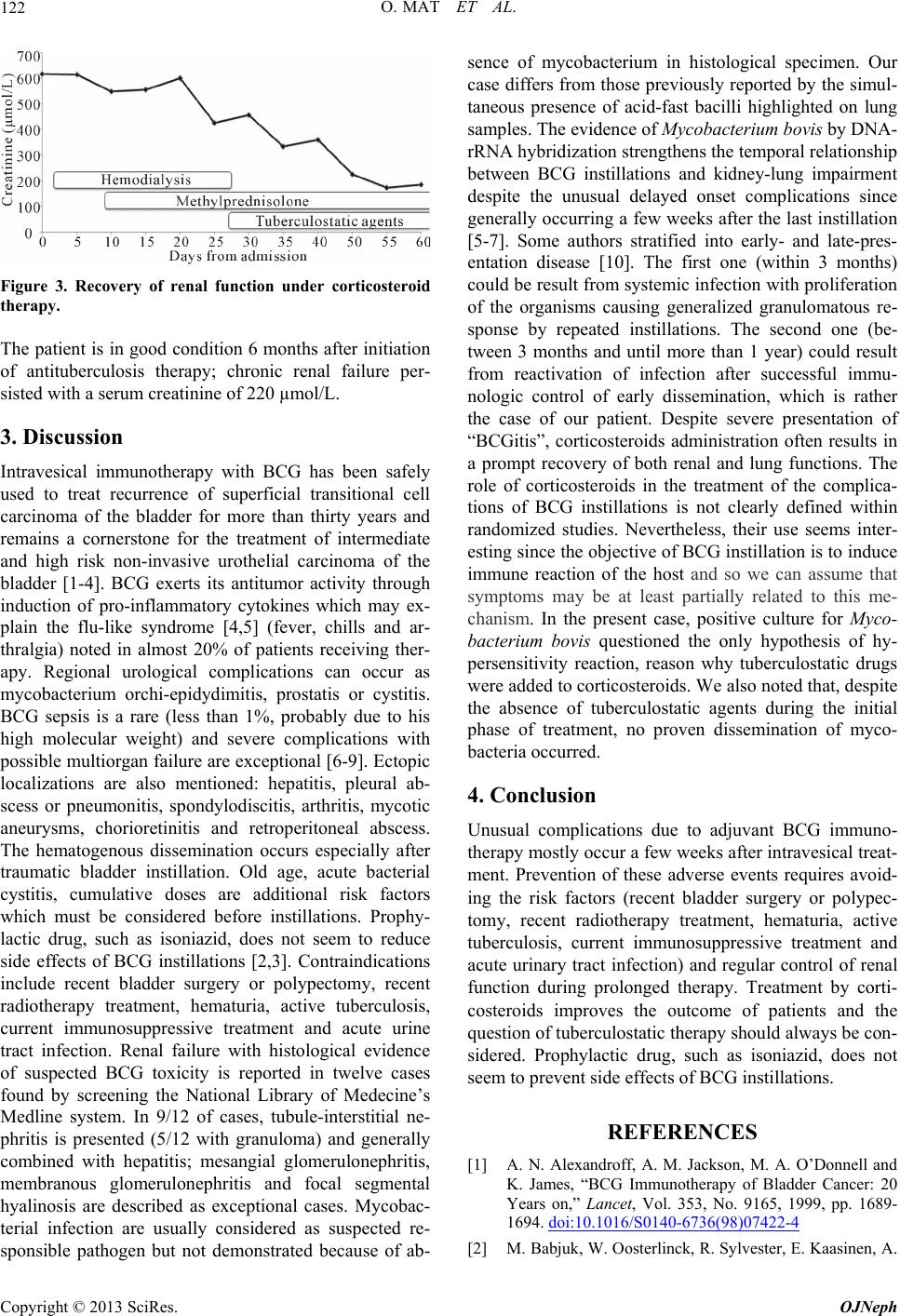
O. MAT ET AL.
122
Figure 3. Recovery of renal function under corticosteroid
therapy.
The patient is in good condition 6 months after initiation
of antituberculosis therapy; chronic renal failure per-
sisted with a serum creatinine of 220 µmol/L.
3. Discussion
Intravesical immunotherapy with BCG has been safely
used to treat recurrence of superficial transitional cell
carcinoma of the bladder for more than thirty years and
remains a cornerstone for the treatment of intermediate
and high risk non-invasive urothelial carcinoma of the
bladder [1-4]. BCG exerts its antitumor activity through
induction of pro-inflammatory cytokines which may ex-
plain the flu-like syndrome [4,5] (fever, chills and ar-
thralgia) noted in almost 20% of patients receiving ther-
apy. Regional urological complications can occur as
mycobacterium orchi-epidydimitis, prostatis or cystitis.
BCG sepsis is a rare (less than 1%, probably due to his
high molecular weight) and severe complications with
possible multiorgan failure are exceptional [6-9]. Ectopic
localizations are also mentioned: hepatitis, pleural ab-
scess or pneumonitis, spondylodiscitis, arthritis, mycotic
aneurysms, chorioretinitis and retroperitoneal abscess.
The hematogenous dissemination occurs especially after
traumatic bladder instillation. Old age, acute bacterial
cystitis, cumulative doses are additional risk factors
which must be considered before instillations. Prophy-
lactic drug, such as isoniazid, does not seem to reduce
side effects of BCG instillations [2,3]. Contraindications
include recent bladder surgery or polypectomy, recent
radiotherapy treatment, hematuria, active tuberculosis,
current immunosuppressive treatment and acute urine
tract infection. Renal failure with histological evidence
of suspected BCG toxicity is reported in twelve cases
found by screening the National Library of Medecine’s
Medline system. In 9/12 of cases, tubule-interstitial ne-
phritis is presented (5/12 with granuloma) and generally
combined with hepatitis; mesangial glomerulonephritis,
membranous glomerulonephritis and focal segmental
hyalinosis are described as exceptional cases. Mycobac-
terial infection are usually considered as suspected re-
sponsible pathogen but not demonstrated because of ab-
sence of mycobacterium in histological specimen. Our
case differs from those previously reported by the simul-
taneous presence of acid-fast bacilli highlighted on lung
samples. The evidence of Mycobacterium bovis by DNA-
rRNA hybridization strengthens the temporal relatio nsh ip
between BCG instillations and kidney-lung impairment
despite the unusual delayed onset complications since
generally occurring a few weeks after the last instillation
[5-7]. Some authors stratified into early- and late-pres-
entation disease [10]. The first one (within 3 months)
could be result from systemic infection with proliferation
of the organisms causing generalized granulomatous re-
sponse by repeated instillations. The second one (be-
tween 3 months and until more than 1 year) could result
from reactivation of infection after successful immu-
nologic control of early dissemination, which is rather
the case of our patient. Despite severe presentation of
“BCGitis”, corticosteroids administration often results in
a prompt recovery of both renal and lung functions. The
role of corticosteroids in the treatment of the complica-
tions of BCG instillations is not clearly defined within
randomized studies. Nevertheless, their use seems inter-
esting since the objective of BCG instillatio n is to induce
immune reaction of the host and so we can assume that
symptoms may be at least partially related to this me-
chanism. In the present case, positive culture for Myco-
bacterium bovis questioned the only hypothesis of hy-
persensitivity reaction, reason why tuberculostatic drugs
were added to corticosteroids. We also noted th at, desp ite
the absence of tuberculostatic agents during the initial
phase of treatment, no proven dissemination of myco-
bacteria occurred.
4. Conclusion
Unusual complications due to adjuvant BCG immuno-
therapy mostly occur a few weeks after intravesical treat-
ment. Prevention of these adverse events requires avoid-
ing the risk factors (recent bladder surgery or polypec-
tomy, recent radiotherapy treatment, hematuria, active
tuberculosis, current immunosuppressive treatment and
acute urinary tract infection) and regular control of renal
function during prolonged therapy. Treatment by corti-
costeroids improves the outcome of patients and the
question of tuberculos tatic therap y should always be con -
sidered. Prophylactic drug, such as isoniazid, does not
seem to prevent side effects of BCG instillations.
REFERENCES
[1] A. N. Alexandroff, A. M. Jackson, M. A. O’Donnell and
K. James, “BCG Immunotherapy of Bladder Cancer: 20
Years on,” Lancet, Vol. 353, No. 9165, 1999, pp. 1689-
1694. doi:10.1016/S0140-6736(98)07422-4
[2] M. Babjuk, W. Oosterlinck, R. Sylvester, E. Kaasinen, A.
Copyright © 2013 SciRes. OJNeph